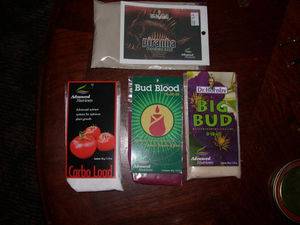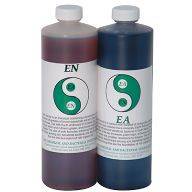G
Guest
Mycorrhizal fungi spores are the special ingredient in all-natural Plant Success Growth Stimulant. These beneficial fungi protect plants' roots from many fungal diseases, improve soil structure and assist with nutrient uptake. The result: stronger, healthier plants and increased yields.
Mycorrhizal Fungi colonize plant roots and extend the root system into the surrounding soil. By attaching to the feeder roots, mycorrhizae greatly extend the effective absorbing area available to plants. Research demonstrates that mycorrhizal filaments can explore volumes of soil hundreds to thousands of times greater than roots themselves. This relationship is beneficial because the plant enjoys improved nutrient and water uptake, disease resistance, superior survival and growth. In addition, the relationship is beneficial by providing more uniform growth, increased leaf size, more flowering and increased vegetable yields.
Under natural conditions, plants live in close association with many soil microorganisms. Some are beneficial others are not. Mycorrhizal fungi act as a bridge allowing beneficial organisms to pass, and prevent harmful pathogens from crossing over, to the plant. To prevent these pathogens from destroying crops most nurseries and farms have resorted to sterilizing the soil either with chemicals or heat. The drawback to this practice is the death of the beneficial microorganisms, which under natural conditions help the plant make food from its surrounding habitat. The soil sterilization process perpetuates the need for more fertilizers unless mycorrhizae are reintroduced into the soil and to the plants. In order to achieve maximum performance nearly all commercially grown plants require mycorrhizae upon transplanting.
What Are Mycorrhizal Fungi?
"Mycor"-"rhiza" literally means fungus root and defines the mutually beneficial relationship between the plant root and the fungus. These specialized fungi colonize plant roots and extend far into the soil resource. Mycorrhizal fungal filaments in the soil are extensions of root systems and more effective in nutrient and water absorption than the roots themselves.
What Plants Form Specialized Roots With Mycorrhizal Fungi?
Over 90% of the world?s plant species form mycorrhizae and require the association for maximum performance in non-artificial conditions.
How Do Mycorrhizal Fungi Increase Nutrient Uptake?
These fungi increase the surface absorbing area of root 10 to 100x thereby greatly improving the ability of the plants to utilize the soil. Several miles of fungal filaments can be present in less than a thimbleful of soil. Mycorrhizal fungi increase nutrient uptake by increasing the surface absorbing area of roots, and by releasing powerful chemicals into the soil that dissolve hard to capture nutrients such as phosphorous, iron and other "tightly bound" soil nutrients. This extraction process is particularly important in plant nutrition and explains why non-mycorrhizal plants require high levels of fertilizers to maintain their health. Mycorrhizal fungi form an intricate web that captures and assimilates nutrients. In non-mycorrhizal conditions much of this fertility is wasted or lost from the system.
What Other Activities Do Mycorrhizal Fungi Do?
Mycorrhizal fungi are involved with a wide variety of other activities that benefit plant establishment and growth. The same extensive network of fungal filaments is important in water uptake and storage. In non-irrigated conditions, mycorrhizal plants are under far less drought stress compared to non-mycorrhizal plants.
Disease and pathogen suppression is another benefit for a mycorrhizal plant. Mycorrhizal fungi attack pathogen or disease organisms entering the root zone. For example, excretions of specific antibiotics produced by mycorrhizal fungi immobilize and kill disease organisms. Some mycorrhizal fungi protect pine trees from Phtophtthora Fusarium and Rhizoctonia diseases. In addition, mycorrhizal roots have a mantle, a tight, interwoven sock like covering of dense filaments that acts as a physical barrier against the invasion of root diseases.
Mycorrhizal fungi also improves the soil structure. Mycorrhizal filaments produce humic compounds and organic "glues" (extracellular polysaccharides) that bind soils into aggregates and improves soil porosity. Soil porosity and soil structure positively influence the growth of plants by promoting aeration, water movement into soil, root growth, and distribution. In sandy or compacted soils the ability of mycorrhizal fungi to promote the improvement of soil structure is as important as seeking out nutrients.
Don't Soils Already Contain Mycorrhizal Fungi?
Undisturbed soils are full of beneficiary soil organisms including mycorrhizal fungi. Research indicates however, many common practices can degrade the mycorrhizal forming potential of soil. Tillage, fertilization, removal of topsoil, erosion, site preparation, road and home construction fumigation, invasion of non-native plants, and leaving soil bare are some of the activities that can reduce or eliminate these beneficial soil fungi. Reintroducing mycorrhizal fungi in areas where they have been depleted can dramatically improve plant establishment and growth.
Many routine nursery practices such as fumigation and high levels of water and nutrients produce non-mycorrhizal plants that can grow well in artificial growing media, however they are poorly adapted to the garden environment.
Mycorrhizal Fungi colonize plant roots and extend the root system into the surrounding soil. By attaching to the feeder roots, mycorrhizae greatly extend the effective absorbing area available to plants. Research demonstrates that mycorrhizal filaments can explore volumes of soil hundreds to thousands of times greater than roots themselves. This relationship is beneficial because the plant enjoys improved nutrient and water uptake, disease resistance, superior survival and growth. In addition, the relationship is beneficial by providing more uniform growth, increased leaf size, more flowering and increased vegetable yields.
Under natural conditions, plants live in close association with many soil microorganisms. Some are beneficial others are not. Mycorrhizal fungi act as a bridge allowing beneficial organisms to pass, and prevent harmful pathogens from crossing over, to the plant. To prevent these pathogens from destroying crops most nurseries and farms have resorted to sterilizing the soil either with chemicals or heat. The drawback to this practice is the death of the beneficial microorganisms, which under natural conditions help the plant make food from its surrounding habitat. The soil sterilization process perpetuates the need for more fertilizers unless mycorrhizae are reintroduced into the soil and to the plants. In order to achieve maximum performance nearly all commercially grown plants require mycorrhizae upon transplanting.
What Are Mycorrhizal Fungi?
"Mycor"-"rhiza" literally means fungus root and defines the mutually beneficial relationship between the plant root and the fungus. These specialized fungi colonize plant roots and extend far into the soil resource. Mycorrhizal fungal filaments in the soil are extensions of root systems and more effective in nutrient and water absorption than the roots themselves.
What Plants Form Specialized Roots With Mycorrhizal Fungi?
Over 90% of the world?s plant species form mycorrhizae and require the association for maximum performance in non-artificial conditions.
How Do Mycorrhizal Fungi Increase Nutrient Uptake?
These fungi increase the surface absorbing area of root 10 to 100x thereby greatly improving the ability of the plants to utilize the soil. Several miles of fungal filaments can be present in less than a thimbleful of soil. Mycorrhizal fungi increase nutrient uptake by increasing the surface absorbing area of roots, and by releasing powerful chemicals into the soil that dissolve hard to capture nutrients such as phosphorous, iron and other "tightly bound" soil nutrients. This extraction process is particularly important in plant nutrition and explains why non-mycorrhizal plants require high levels of fertilizers to maintain their health. Mycorrhizal fungi form an intricate web that captures and assimilates nutrients. In non-mycorrhizal conditions much of this fertility is wasted or lost from the system.
What Other Activities Do Mycorrhizal Fungi Do?
Mycorrhizal fungi are involved with a wide variety of other activities that benefit plant establishment and growth. The same extensive network of fungal filaments is important in water uptake and storage. In non-irrigated conditions, mycorrhizal plants are under far less drought stress compared to non-mycorrhizal plants.
Disease and pathogen suppression is another benefit for a mycorrhizal plant. Mycorrhizal fungi attack pathogen or disease organisms entering the root zone. For example, excretions of specific antibiotics produced by mycorrhizal fungi immobilize and kill disease organisms. Some mycorrhizal fungi protect pine trees from Phtophtthora Fusarium and Rhizoctonia diseases. In addition, mycorrhizal roots have a mantle, a tight, interwoven sock like covering of dense filaments that acts as a physical barrier against the invasion of root diseases.
Mycorrhizal fungi also improves the soil structure. Mycorrhizal filaments produce humic compounds and organic "glues" (extracellular polysaccharides) that bind soils into aggregates and improves soil porosity. Soil porosity and soil structure positively influence the growth of plants by promoting aeration, water movement into soil, root growth, and distribution. In sandy or compacted soils the ability of mycorrhizal fungi to promote the improvement of soil structure is as important as seeking out nutrients.
Don't Soils Already Contain Mycorrhizal Fungi?
Undisturbed soils are full of beneficiary soil organisms including mycorrhizal fungi. Research indicates however, many common practices can degrade the mycorrhizal forming potential of soil. Tillage, fertilization, removal of topsoil, erosion, site preparation, road and home construction fumigation, invasion of non-native plants, and leaving soil bare are some of the activities that can reduce or eliminate these beneficial soil fungi. Reintroducing mycorrhizal fungi in areas where they have been depleted can dramatically improve plant establishment and growth.
Many routine nursery practices such as fumigation and high levels of water and nutrients produce non-mycorrhizal plants that can grow well in artificial growing media, however they are poorly adapted to the garden environment.






